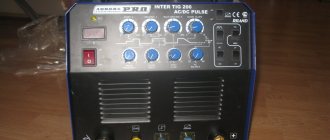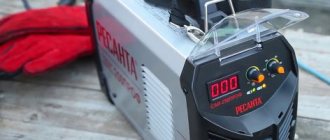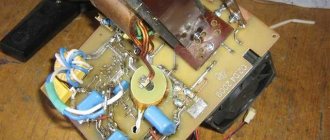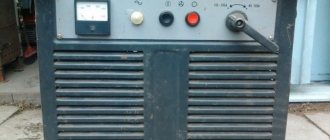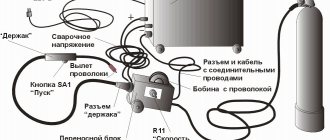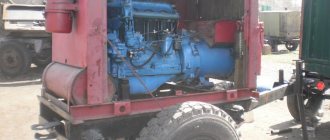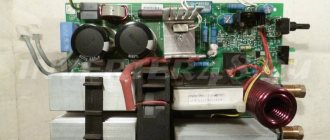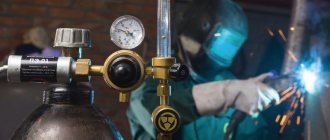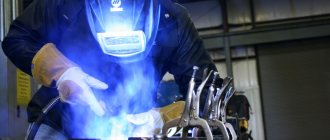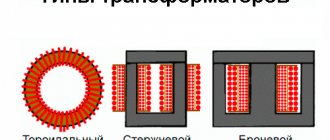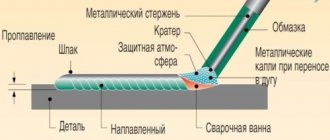Home / Devices
Back
Reading time: 2 min
0
1089
Those who have had to use welding devices at home have probably heard about such a miracle of technology as a wire welding machine. What is it, what is it for and what is it good for?
A wire machine is a semi-automatic device that uses not electrodes, but metal wire and gas or flux.
The peculiarity of the operation of such a device is that the built-in mechanism in a semi-automatic mode supplies filler material - wire - to the welding zone.
- general characteristics
- Process technology
- Advantages and disadvantages
- Conclusion
What is MIG/MAG
The wire has such qualities as flexibility and thinness. And its use allows you to reduce the spattering of molten metal, increase the size of the weld pool and the depth of welding. Using semi-automatic wire machines, you can weld different grades of steel, non-ferrous metals, and other materials.
Modern wire welding machines use MIG/MAG technology. What do these English abbreviations mean? MIG is Metal Inert Gas and MAG is Metal Action Gas.
That is, what kind of gas is used in the welding process is of key importance here. If it is inert helium, then the technology should be called MIG, and if welding is carried out with CO2 gas, which is classified as active, then MAG.
The welding process with machines that support MIG/MAG technology is quite simple. Even craftsmen without serious experience in the profession can achieve decent seam quality and a good level of productivity.
With a semi-automatic welding machine it is possible to work spotwise and create continuous seams up to 40 meters long. Anyone today can purchase one of these devices in specialized stores, and it will definitely come in handy in the household.
In the design of a semi-automatic wire welding machine, three main elements can be distinguished: a transformer (or inverter) that generates an electric arc; a conveyor responsible for feeding the wire electrode; and a control unit, whose main task is to synchronize all processes.
Advantages and disadvantages
Another advantage of semi-automatic wire welding machines is that they cope with welding all types of metals.
When manually arc welding aluminum or stainless steel, the process is complicated by the formation of an oxide film on the surface of the metal, but this can be avoided by using gas or flux.
Due to the stability of the arc during automatic feeding, it is possible to achieve high quality welds without lack of penetration or burn-through.
This allows you to weld both thin sheets and fairly thick workpieces without compromising the quality of the welded joint.
The main advantage of wire semi-automatic machines is high productivity with relative ease of use. Even for simple, mid-priced models, there are usually many customization options.
But don’t be afraid of this - most of these settings are intuitive and will not complicate the use of the device.
The disadvantage of semi-automatic wire welding machines is the need to purchase additional equipment (a gas cylinder with a reducer, a torch) and the flux-cored wire itself.
That is, for a small amount of welding work at home, buying a semi-automatic machine may be irrational. For home use, it may be easier and cheaper to buy coated electrodes and cook with a conventional inverter.
But in series production, these additional costs will be recouped through high levels of productivity.
If the production is not a conveyor belt, then it is convenient to use small carts to move the semi-automatic machine with all additional equipment between objects.
Operation without shielding gas
MIG/MAG technology by default involves the use of wires in combination with a shielding gas - argon, helium, nitrogen or carbon dioxide. But home craftsmen are reluctant to use this method, because creating a gas environment entails a number of costs and inconveniences.
For welding work, you will need to have a cylinder with some kind of inert or active gas. From time to time, these cylinders will need to be refilled at a specialized station.
Moreover, refilling will become especially expensive and costly if the welding machine is not used very often. Moreover, the presence of cylinders and additional equipment leads to the fact that the welding machine loses its mobility.
However, there is an alternative - in practice, wire MIG/MAG welding machines can be used effectively without gas. To do this, you need to purchase flux-cored wire.
It is relatively inexpensive, and its presence allows the master to practically forget about complex preparatory procedures. You just need to insert this wire into the place intended for it, turn on the device and start working.
Flux-cored welding wire for semi-automatic and automatic welding is slightly thicker than usual. This is due to the fact that inside it there is a rod made of a substance that improves the welding process (this is flux).
Thus, the wire can be bent, cut into pieces, and so on - this will not affect its performance characteristics in any way.
DC transformer machines for welding with consumable electrodes.
The design is similar to previous devices, but a diode or thyristor rectifier is installed at the output. The alternating current is rectified, but some power is lost. The design is more complex, heavy and expensive. But working on direct current is more comfortable, the arc is more stable. In addition to welding ferrous metals, it is possible to work with stainless steel and non-ferrous metals using appropriate electrodes. Direct current has polarity, so this must be taken into account when selecting and connecting electrodes. There are also electrodes for direct current, and there are universal ones. Recently, many manufacturers are refusing to produce this type of hobby-class devices.
But in professional activities they are widely used.
The characteristics for these devices are the same as the previous type.
Wire selection
You should not choose the cheapest (most likely made in China) option. After all, the quality of the future connection depends on the additive. GOST 2246-70 specifies more than 75 types of wire for semi-automatic welding machines.
In addition, there are several dozen more types of wire products, whose characteristics are determined by the Technical Conditions (TU).
The wire should be selected so that it matches the metal being welded . That is, for example, aluminum wire is only suitable for aluminum products. At the moment, both ordinary aluminum (steel, copper, nickel, etc.) wires and products with a flux layer inside can be found on the open market.
But to create a high-quality seam, the wire machine must have an impeccable feeding and pulling algorithm. So far, only devices made in the European Union can boast of this.
By the way, flux-cored wire itself, made from the same aluminum, can have a very high cost, which will certainly not suit all home craftsmen.
Which semi-automatic welding machine is better to buy?
After the most popular and reliable brands of budget, semi-professional and professional inverters were named, it remains to make a choice in favor of one nominee. You can rely on goals, scope of work, price tag, reviews of welders and users. The following review results will tell you which semi-automatic welding machine to choose:
- For household work - Resanta SAIPA-135;
- For a professional with simple work - Elitech IS 250PN;
- For car service and garage work - BlueWeld Starmig 210 Dual Synergic;
- For three-phase network and different conditions - Svarog MIG 3500 (J93) (TIG, MIG/MAG, MMA);
- For industry, working with different thicknesses of metal - Forsazh 502 (TIG, MIG/MAG, MMA).
Any semiautomatic welding machine considered, without gas or with it, guarantees high-quality execution of tasks and facilitates repair or finishing work. What to buy is a purely personal decision for each individual, taking into account performance, functionality, compatibility with the electrical network and materials for processing.
Refueling and consumption
In order for the welding operation to proceed quickly and without errors, you need to correctly thread the wire into the machine. This is done as follows:
- Usually welders buy one or more wire spools at a time. After unwinding a small piece, straighten the outermost 10 centimeters using wire cutters;
- then you should examine whether there are any traces of corrosion or contamination on the wire surface. If everything is fine, then you need to advance the wire thread a few centimeters into the so-called liner (this is a tube in the area of the device sleeve);
- Now you need to turn on the semi-automatic welding machine and start working, not forgetting to make sure that the bends of the sleeve are not too strong and sharp. Because of this, the wire may well get stuck and break in it.
It is equally important during welding or in advance to find out at least the approximate consumption of welding wire. N
and the consumption rate is influenced by such parameters as the chemical composition of the metal, the thickness of the wire itself, and the technical characteristics of the welding machine.
In many cases, it is believed that the weight of the wire should be equal to 1.5% of the weight of the parts being welded. And the weight of the deposited material is always 6-10% less than the weight of the wire (this 6-10% “eats” the waste).
Open sources also indicate that the consumption of flux-cored wire per second during semi-automatic welding can range from 3 to 25 cm. Obviously, much will depend on the speed of the master welder.
Which company's semi-automatic welding machine is better to choose?
Due to the wide variety of brands of such complex technical equipment, the buyer's choice can be difficult. Experts recommend taking into account the reputation, experience of manufacturers, and what advantages they have that set them apart from their competitors. In the domestic market, the greatest demand is observed among the following companies:
- Wester is a trademark that belongs to the group. The main production is located in China. Under this name, auto tools, welding machines, pneumatics, household and semi-professional equipment for construction and repair work are presented on the Russian market. Demand is observed not only in Russia, but also in many European countries.
- Aurora is a Russian company that represents high quality equipment with a minimum warranty period of 2 years or more. Welding equipment is assembled in China. In addition, the range is constantly updated with new models of compressors, generators, mini-washers, and pumps.
- Resanta is a young Latvian company that produces high-quality electrical equipment at low prices. On the Russian market you can see a wide range, among which MAG/MIG semi-automatic welding machines will be presented in dozens of varieties in terms of power and other parameters.
- Elitech is a Russian company that entered the market in 2008. Despite the short production period, it has already mastered the production of a wide range of high-quality equipment with affordable price tags. The main factories are located in China, where the products are also in demand.
- Fubag is a German company operating since 2007. Most of the products are welding equipment and related products with good technical characteristics and average prices. Today Fubag has become a partner for most professionals.
- FoxWeld is a large-scale manufacturing and trading company that sells electric and gas welding equipment assembled from consumables of Asian and European origin. Being a Russian company, cooperation is carried out only with branded suppliers of parts, components, and raw materials.
- BlueWeld is an Italian manufacturer offering various welding machines, components, accessories, and branded accessories for them. The company has been operating since 1963, since then the company has achieved a high rate of sales growth on the Russian market, and it has been able to improve the quality and characteristics of its products thanks to its own scientific laboratory.
- Svarog is a Russian manufacturer that introduced equipment for repairs and construction work to the market. All products were released subsequently in cooperation with the Chinese company Shenzhen Jasic Technology.
- Brima is one of the oldest German companies presenting welding equipment on the Russian market. Work experience has exceeded 50 years. You can work with such devices even if you have no experience, since each unit is reliable and multifunctional.
- Forsazh is a trademark owned by the Russian company. Over 20 years of fruitful work, the company has established customer service and introduced advanced functions, which made it possible to create professional-level tools. Inverter welding machines are in greatest demand.
How to cook
Wire welding differs from the “gas” method in its more gentle consumption of materials and low energy intensity of the process. In fact, these are two main advantages.
The welding process itself is as follows. The wire inserted into the welding machine passes through a small sleeve into the holder, and then forms an electric arc that is in direct contact with the metal workpieces being welded.
The filler material (flux) burns and melts under the influence of an electric arc, releasing carbon dioxide. And it, in turn, reliably isolates the weld pool from oxygen in the surrounding atmosphere and creates obstacles to excessive melting of parts.
In general, semi-automatic welding without gas has few differences from the standard “arc” process. But still, the use of cored wire imposes certain limitations. Flux-cored wire is quite fragile, and the welder will have to handle the machine holder very carefully.
The very fact of the release of carbon dioxide makes this method unacceptable for creating ceiling joints. Even vertical seams will be difficult. But with traditional horizontal seams, no insurmountable difficulties should arise.
However, in some cases, someone who welds with wire without gas will probably have to go over some areas again in order for the flux to be completely removed from the surface.
There are also certain restrictions on the size of welds. A wire electrode with a diameter of up to two millimeters is physically incapable of creating a wide and deep connection.
In addition, it is important to observe polarity and correctly connect the cathode and anode of the wire apparatus. The greatest power must be transmitted to the holder; it must be used to melt the wire additive.
There is no point in using ordinary wire in such a welding process - without the protective gas environment, the molten metal will either all splash out to the sides (if the current is too high), or will often “stick” (if the current is insufficient).
Types of semi-automatic machines (wire machines)
Semi-automatic is a very multifunctional welding machine. It is capable of welding using wire under a layer of flux or in a protective gas environment, welding using special self-shielding wire (cored wire), as well as classic manual arc welding.
Most semi-automatic machines are capable of performing only one of the listed types of welding. But there are models that can do everything. They are the most versatile and are able to perform welding of any complexity.
Gas shielded wire welding is the most common. With this welding method, the wire acts as an electrode and at the same time melts, mixing with the base metal. And the gas protects the weld pool from oxidation. Submerged arc welding is often used in industry. But welding with self-shielding wire deserves special attention.
With this welding method, you do not need to use gas or flux. It is enough to insert a special flux-cored wire into the semi-automatic machine and start welding. Flux cored wire is essentially a hollow metal tube that contains flux inside. During the welding process, the metal tube melts and the flux is released. And it begins to play the same role as the shielding gas.
It would seem that this is an ideal welding technology. But the problem is that the seams obtained with this welding method are far from ideal. Self-shielding wire can only be used in emergency cases when other welding methods cannot be performed.
Required device parameters
In order to work correctly with flux-cored wire electrodes, welding machines must have the following parameters:
- welding current strength from 35 A;
- power from 1.5 kW or more;
- The diameter of the wires used is from 0.5 to 2 mm.
The current strength can be adjusted using rheostats located in the control unit. When selecting the optimal wire size, the welding conditions (thickness of the metal products being joined, type of alloy or metal) must be taken into account.
As for the power of the wire machine, it directly affects productivity and cost. The greater the power, the more the wire apparatus costs and the greater its efficiency.
Selecting a semi-automatic machine (wire machine)
The first thing you need to pay attention to when choosing a semi-automatic machine is its purpose. Or, more simply put, class. The class can be domestic, semi-professional or professional. To understand what class the device belongs to, you can find out its technical characteristics or look in the instructions.
But the technical characteristics are the easiest way to determine the class of a semi-automatic device. If the maximum current is up to 200 Amperes, then you have a household welding machine. Semi-professional semi-automatic devices can be up to 300 Amps, this is the golden mean. But professional welders weld from 300 Amps and more.
For welding in the country or in the garage, a household machine will be enough for you. If you regularly weld car bodies, then it is better to take a closer look at semi-professional machines. Professional models are used in factories or workshops where complex, long-term welding is performed daily.
We would like to draw your attention to the cost of the device. Buying the cheapest semi-automatic is a bad idea. It quickly breaks down, and its technical characteristics often do not correspond to real indicators. It is better to buy a device from the middle price category. If you really want to buy a high-quality semi-automatic machine, but there is not enough money, then you can look for something used on online bulletin boards.
Also make sure that the device you purchase has an official warranty. It is better if it comes directly from the manufacturer and not from the store.
Inverter type welding machines. Inverters.
They are also called impulse. These machines were invented in 1977. The most advanced welding machines. Very widely used all over the world. In recent years, they have also gained well-deserved popularity in Russia.
Many types of devices, as well as their combinations, are now produced based on inverter technology. They are characterized by very low weight (from 3 kg), dimensions, and low dependence on input voltage. To improve the quality and comfort of welding work, they are equipped with stabilization circuits, enhancing arc ignition and protection against very low or high supply voltage. They have a very high open circuit voltage of 85-90V. Inverter is a direct current device. The supply voltage at the input is rectified and then converted into alternating voltage with a frequency of 20 - 45 kHz, which is supplied to the transformer. Because the voltage frequency is high, it becomes possible to use a transformer of small size and weight. At the output, the voltage is rectified.
All these advantages more than compensate for the higher cost.
